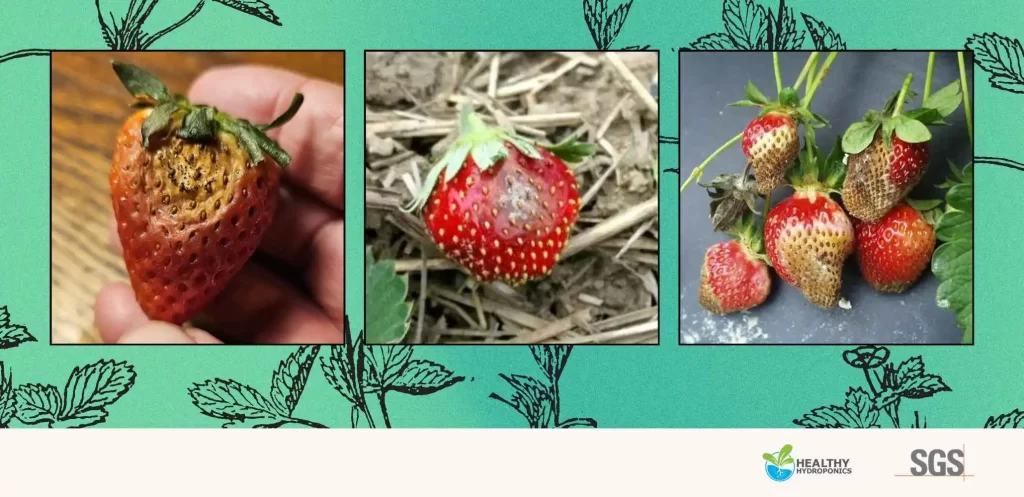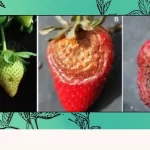Indoor Strawberries: Top 3 Plant Pathogens to Watch For
While controlled environments offer many advantages for indoor strawberries, they also create the perfect conditions for certain plant pathogens to thrive.
In 2024, agricultural experts are drawing attention to three major pathogens impacting strawberry crops: Botrytis cinerea (Gray Mold), Neopestalotiopsis spp., and Phytophthora spp. To help you stay informed, we’ve collected insights from universities and agricultural extension services on effectively managing these threats.
Botrytis cinerea (Gray Mold)
Botrytis cinerea, commonly known as gray mold, is a fungal pathogen that can cause significant losses in strawberry crops, particularly in indoor environments with high humidity. According to Cornell University, Botrytis thrives in cool, humid conditions (59°F to 72°F /15°C to 22°C) and can cause up to 50% yield loss if not properly managed. The pathogen infects flowers and fruits, leading to rapid decay and the appearance of a gray, fuzzy mold.
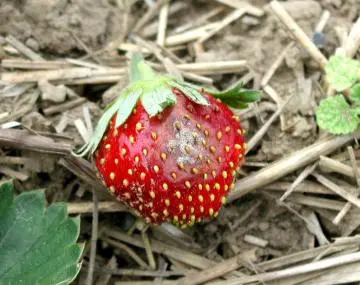
Why It’s a Threat:
- Cornell University notes that Botrytis requires 13-16 hours of leaf wetness for infection, making it particularly dangerous in environments with poor air circulation.
- UF/IFAS highlights that Botrytis is a polycyclic pathogen, meaning it continuously produces spores throughout the growing season. This makes it particularly dangerous in environments with poor air circulation or prolonged leaf wetness.
- The pathogen spreads via spores carried by wind or water, making it difficult to contain once established.
Management Tips:
- Penn State University recommends reducing humidity levels below 85% and ensuring proper air circulation within your indoor growing space.
- Properly remove any dead or decaying plant material promptly, as Botrytis survives on organic matter.
We provide great overviews of many agricultural microorganisms. Subscribe to stay updated!
2. Neopestalotiopsis spp.
Neopestalotiopsis is an emerging plant pathogen that has caused significant concern among indoor strawberries in recent years. Formerly known as Pestolia, the name has been updated. A recent study by Baggio et al. (2020) indicates that isolates previously identified as Pestalotiopsis longisetula should now be classified as Neopestalotiopsis rosae. We talked more about its history and rise in this blog.
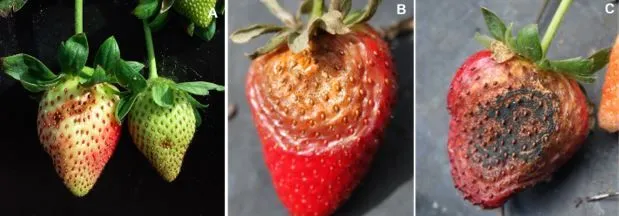
According to the University of Georgia Extension, this pathogen made headlines during the 2024-2025 season due to widespread infections in nurseries and production fields. Neopestalotiopsis causes leaf spots, fruit rot, and crown rot, making it a serious threat to indoor strawberry crops.
Why It’s a Threat:
- The University of Arkansas Extension reports that Neopestalotiopsis can survive on plant debris for up to 15 months, making it difficult to eliminate once it has infected a crop.
- The University of Wisconsin and UF/IFAS show this pathogen thrives in warm, humid conditions—common in indoor growing environments—and can spread rapidly through infected transplants or contaminated water.
Management Tips:
- The Southern Region Small Fruit Consortium (NCSU) recommends starting with clean planting stock from reputable nurseries and rotating crops every two years to prevent inoculum buildup.
- NC State University reports observations from growers and nursery workers that certain cultivars are more susceptible and show more disease symptoms.
- Cultivars Monterey, Rocco, and Fronteras show fewer disease symptoms.
- Cultivars Ruby June, Albion, Chandler, Camarosa, Sweet Charlie, Camino Real, Brilliance, and Sensation show more disease symptoms.
- These are based on observations, but no research trial has been conducted to see disease development in different cultivars
- Ensure proper sanitation practices by removing infected plant material and disinfecting equipment between uses.
3. Phytophthora spp. (Leather rot)
Phytophthora spp. are soil-borne pathogens that causes leather rot in strawberries. This disease is particularly problematic for indoor growers because it thrives in poorly drained soils or over-irrigated systems. According to the UF/IFAS, Phytophthora accounts for approximately 30% of strawberry crown rot cases diagnosed in their clinic.
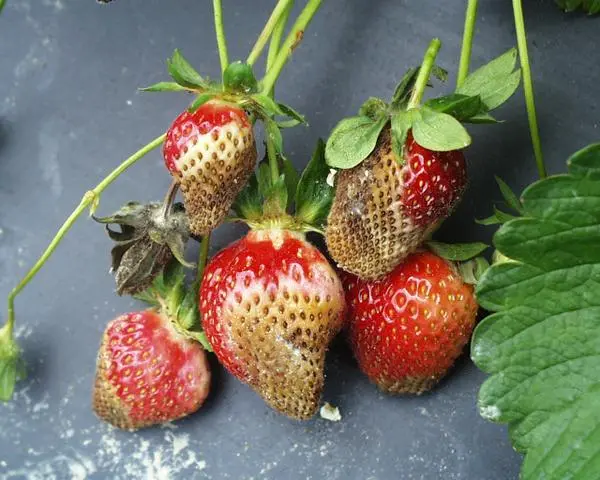
Why It’s a Threat:
- The pathogen infects the crown of the plant, causing it to wilt and die rapidly during fruit development. If not caught early, Phytophthora can devastate an entire crop.
- The NC State University Extension highlights that Phytophthora spreads through contaminated water or infected transplants and can survive in soil for long periods as resistant spores.
Management Tips:
- Use disease-free transplants from trusted sources to prevent introducing the pathogen into your system.
- UF/IFAS suggests thermotherapy for transplants (plant sauna at 37°C (98.6°F) for 1 hour followed by 44°C (111.2°F) for 4 hours) to increase chances of survivability of infected plant stock
- Regularly monitor soil moisture levels and adjust irrigation practices accordingly.
Protect Your Indoor Strawberries from Plant Pathogens
Managing Botrytis cinerea, Neopestalotiopsis, and Phytophthora in an indoor environment requires a comprehensive, proactive approach. Based on expert recommendations from universities and agricultural extensions, here’s a consolidated list of management practices that can help you protect your strawberry crop from all three pathogens.
-
Control Humidity Levels
High humidity is a major factor in the development of fungal pathogens like Botrytis and Neopestalotiopsis. Keeping humidity levels consistent throughout the growing cycle is key to preventing outbreaks.
- Optimal Humidity Range: According to Cornell University and UF/IFAS, keeping humidity below 85% is critical for preventing Botrytis infections, while lower humidity also helps reduce the risk of Neopestalotiopsis.
- Air Circulation: Ensure good air circulation throughout your indoor growing space to prevent moisture buildup on plant surfaces. Use fans or ventilation systems to keep air moving and reduce condensation on leaves and fruit.
-
Monitor & Scout Regularly
Early detection is key to managing pathogen outbreaks before they spread throughout your crop.
- Regular Inspections: Conduct frequent inspections of your plants for any signs of disease, such as leaf spots, fruit rot, wilting, or discoloration. Early intervention can prevent minor infections from becoming major problems.
- Lab and Water Testing: Lab testing of water quality ensures that pathogens like Phytophthora or Pythium are detected early, allowing growers to treat the water before it spreads disease throughout the system.
-
Sanitation Practices
Proper sanitation is essential for minimizing the spread of all three pathogens, as they can persist on plant debris, tools, and equipment.
- Remove Plant Debris: Regularly remove dead or decaying plant material from your growing area. According to the University of Arkansas Extension, Neopestalotiopsis can survive on plant debris for up to 15 months, so keeping your environment clean is crucial.
- Disinfect Tools & Equipment: Clean and disinfect all tools, containers, and surfaces that come into contact with plants. Use a 10% bleach solution or commercial disinfectants between uses to kill any lingering pathogens.
- Sanitize Growing Media: If pots or containers are reused, sterilize them before introducing new plants. This is particularly important for controlling soil-borne pathogens like Phytophthora.
-
Use Disease-Free Transplants
Starting with healthy plants is one of the most effective ways to prevent introducing pathogens into your indoor system.
- Source from Reputable Nurseries: Always purchase transplants from nurseries that follow strict disease management protocols. The University of Georgia Extension stresses the importance of using disease-free stock to avoid introducing pathogens like Neopestalotiopsis or Phytophthora into your growing area.
- Inspect Transplants: Before planting, inspect transplants for any signs of disease, such as discoloration, spots, or wilting. Discard any plants that show symptoms of infection.
-
Manage Watering & Drainage
Water management is critical for controlling soil-borne pathogens like Phytophthora, which thrives in wet conditions.
- Proper Flow and Drainage: The NC State Extension recommends ensuring adequate drainage in your growing system.
- Water at the Base: Rather than overhead, water plants at the base to minimize leaf wetness and reduce the risk of fungal infections like Botrytis and Neopestalotiopsis.
- Monitor Soil Moisture: Use moisture sensors or manual checks to ensure soil remains consistently moist but not saturated.
-
Integrated Pest Management (IPM)
An integrated approach combining cultural practices with biological controls can reduce reliance on chemical fungicides while effectively managing disease pressure.
- Biological Controls: Consider using biological fungicides such as Trichoderma or Bacillus-based products that target fungal pathogens without harming beneficial organisms.
Summary:
By implementing these best practices—controlling humidity, maintaining sanitation, using disease-free transplants, managing water carefully, scouting regularly, and integrating biological controls—you can significantly reduce the risk of pathogen outbreaks in your indoor strawberry operation. These strategies are based on leading agricultural experts’ recommendations at Cornell University, UF/IFAS, NC State Extension, University of Arkansas Extension, and others.
Stay Ahead of the Game
Want more tips on protecting your crops from emerging threats? Subscribe to our blog for the latest updates on plant health management, disease prevention strategies, and expert insights from top universities like Cornell, Penn State, UF/IFAS, NC State, and more!
Disclaimer
The information we present in this blog is based on collating published peer-reviewed scientific literature, and sources we think are reliable. This is by no means an exhaustive review of pathogens. This blog gives a small glimpse of what is known about pathogens. We encourage growers to do more research on the pathogens concerning their crops and hydroponic systems. We are not plant pathologists; thus, the information presented should not be used as professional advice to treat pathogens or operate your system.
David Santos is the CMO of Healthy Hydroponics InnoTech


